INN PAW KHON, MYANMAR - The boatman frowned at my instructions. “Inn Paw Khone,” I told him, naming a village built on stilts toward the far end of Inle Lake, in central Myanmar. The lake holds many attractions, including vegetable gardens that float in the water, and fishermen who paddle with one leg while standing in their dugout canoes. Most visitors want to see as many sights as possible.
“Jumping cats monastery?” the boatman suggested, naming a shrine where cats are trained to jump through hoops. “Hpaung Daw U Pagoda?” he said, naming one of the country’s most recognized Buddhist shrines.
“Just the village,” I said, promising to pay full price — $20 (Cdn) — if I could stay all day. “I want to see the lotus weavers.”
The women of Inn Paw Khon spin fibre from the long-stemmed lotus plant into thread and weave the thread into cloth. It is a tedious, painstaking process, invented 150 years ago by a local woman named Daw Sar Ou. Like most Buddhists, she regarded the lotus plant as holy, a symbol of enlightenment, for the way its flower floats free of life’s metaphorical muddy waters. Twice every lunar month, the woman would bring an offering of lotus flowers to her neighbourhood monastery, and one day she thought of turning the plant into a monk’s robes. When the fibre proved fragile and difficult to work with, she developed a way to twist and spin it into thread, then to coat the thread with cooked rice and wax to prepare it for weaving. Because a monk’s outfit consists of two generous-sized robes, the project took an entire year.
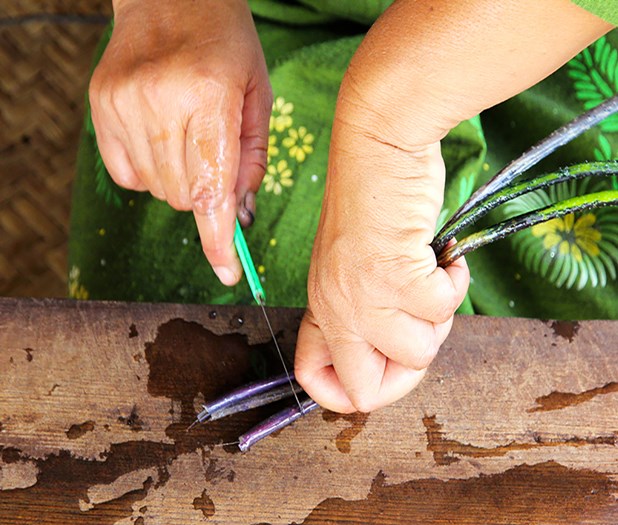
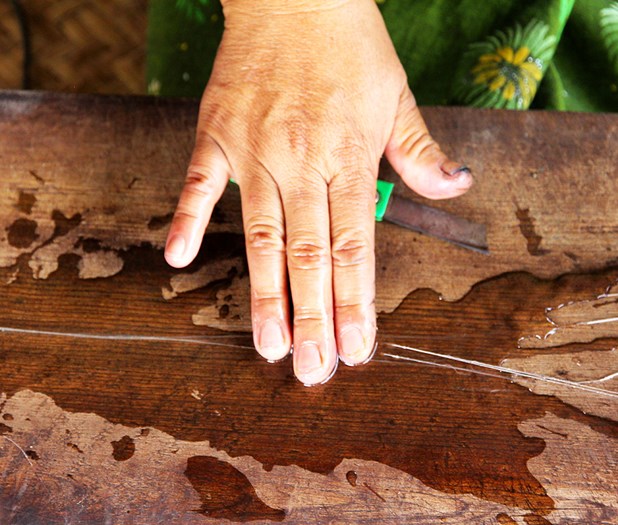
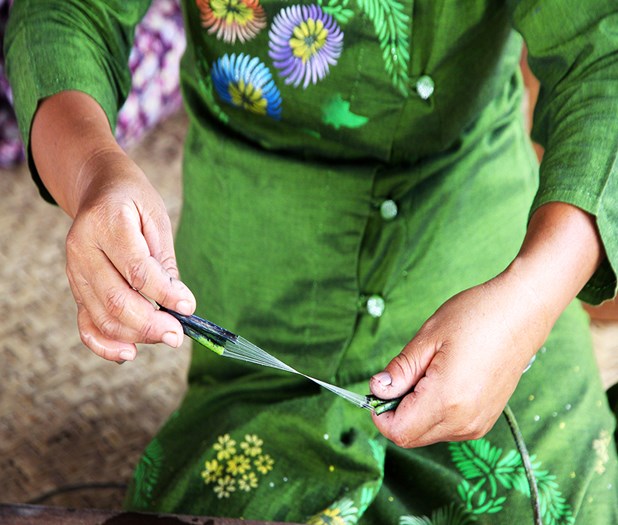
Above: A weaver demonstrates how the lotus plant is turned in to fine fabric.
Afterward, other Inle Lake weavers learned to make monk’s robes from lotus fibre. Wealthy devotees would buy the robes to donate to a monastery. In 1996, the Myanmar government relaxed tourist restrictions to Inle Lake and the outside world discovered the cloth for the first time.
Lotus fabric is exquisite. In looks a lot like linen and feels like raw silk. It is naturally waterproof and stain resistant. Because of the labour involved, it is also rare and expensive. At Inle Lake, a monk’s outfit costs $4,500 (U.S.). A narrow one-metre scarf costs $100. Since 2010, Italian clothing manufacturer Loro Piana has been importing Inle Lake lotus cloth to make sports coats that sell for as much as $12,000 each. Monk’s robes are dyed saffron, but most of the scarves and the Italian jackets retain their natural, warm, beige colour.
The boatman and I roared off in his long, narrow skiff, kicking up a fountain of spray. From the docks at Nyaungshwe, at the north end of the lake, we jetted through a narrow channel to the lake proper, where we buzzed past the floating gardens and leg-paddling fishermen. After an hour’s travel, near the lake’s south end, we arrived at Inn Paw Khon village, where eight of the dozen or so of the lake’s lotus-weaving centres can be found.
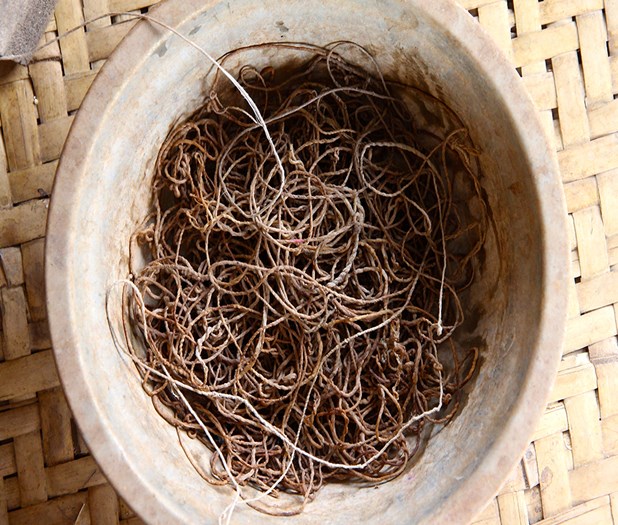
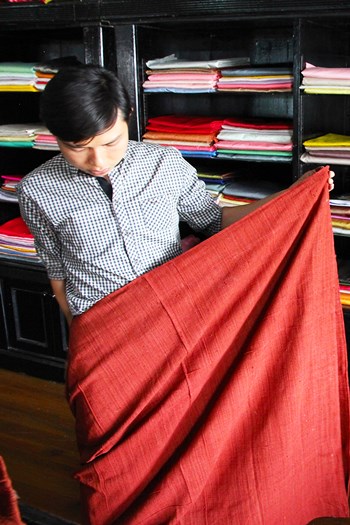
Left: Lotus fabric is among the strongest in the world. Right: High end fashion shops now sell lotus designs.
The whole village looked perched in the air. The lake rises and falls with the wet and dry seasons, and I was visiting in May, the driest time. We docked at a set of barn-like buildings balanced on wooden poles three-metres high.
“Khit Sunn Yin,” the sign said, naming the company, and I climbed a ladder to a porch-like walkway that ran the length of the complex. Of all the lotus-weaving centres on the lake, this was one of the oldest, founded in 1932.
“To make one scarf takes 4,000 lotus stems,” manager Kyaw Zin Tun said as he started me on a tour. “To make the thread for one scarf takes 20 days. To weave it takes one day.”
Lotus cloth manufacturing is essentially a cottage industry, the manager said, with stem-harvesters, thread-makers, and most of the weavers working from home. The weaving centre, which also produces silk and cotton cloth, serves as a visitors’ showcase.
I spent most of the day watching the spinners and weavers, admiring their patience and meticulousness. I drank tea in the tearoom. I bought two of the $100 scarves. For a long time, I watched a woman named Aye Aye Mu extract strands of fibre as thin as spider silk from stacks of lotus stems.
She sat cross-legged on the porch at a smoothly finished wooden bench. With a razor-sharp knife, she briskly cut incisions into two or three stems at a time, broke off the pieces, pulled out strands of gossamer, and stretched them in front of her on the wood. She was cutting stem lengths of only a few centimetres and pulling out fibres more than a third of a metre long, repeating the process over and over down the stem.
“How does she keep pulling long fibres from short pieces of stem?” I asked the manager.
“The fibre is not fibre,” he answered enigmatically. On contact with the air, he said, liquid in the stem instantly turns solid to create the long, delicate filaments.
It seemed an almost magically property, as good a reason as any to regard the lotus plant as holy.
Information
Tour East Holidays (
www.toureast.com) has many value-priced tours to Myanmar.
About the Author
As the Toronto Star’s world-music reporter, John Goddard travelled frequently to Africa to hear singers everywhere from Khartoum to Timbuku. Afterward, he started wandering closer to home. By foot and subway, he reached all of Toronto’s small heritage museums and wrote the book Inside the Museums: Toronto’s Heritage Sites and Their Most Prized Objects. He then rode the intercity GO bus to write the companion volume, Inside Hamilton’s Museums. Both local and foreign destinations continue to draw him. As a longtime Asia Pacific Foundation of Canada Media Fellow, he recently resolved to delve deeper into the delights of Southeast Asia.